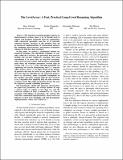The LevelArray: A Fast, Practical Long-Lived Renaming Algorithm
Author(s)
Alistarh, Dan; Kopinsky, Justin; Matveev, Alexander; Shavit, Nir N.
DownloadShavit_The levelarray.pdf (474.0Kb)
OPEN_ACCESS_POLICY
Open Access Policy
Creative Commons Attribution-Noncommercial-Share Alike
Terms of use
Metadata
Show full item recordAbstract
The long-lived renaming problem appears in shared-memory systems where a set of threads need to register and deregister frequently from the computation, while concurrent operations scan the set of currently registered threads. Instances of this problem show up in concurrent implementations of transactional memory, flat combining, thread barriers, and memory reclamation schemes for lock-free data structures. In this paper, we analyze a randomized solution for long-lived renaming. The algorithmic technique we consider, called the Level Array, has previously been used for hashing and one-shot (single-use) renaming. Our main contribution is to prove that, in long-lived executions, where processes may register and deregister polynomially many times, the technique guarantees constant steps on average and O (log log n) steps with high probability for registering, unit cost for deregistering, and O (n) steps for collect queries, where n is an upper bound on the number of processes that may be active at any point in time. We also show that the algorithm has the surprising property that it is self-healing: under reasonable assumptions on the schedule, operations running while the data structure is in a degraded state implicitly help the data structure re-balance itself. This subtle mechanism obviates the need for expensive periodic rebuilding procedures. Our benchmarks validate this approach, showing that, for typical use parameters, the average number of steps a process takes to register is less than two and the worst-case number of steps is bounded by six, even in executions with billions of operations. We contrast this with other randomized implementations, whose worst-case behavior we show to be unreliable, and with deterministic implementations, whose cost is linear in n.
Date issued
2014-06Department
Massachusetts Institute of Technology. Computer Science and Artificial Intelligence Laboratory; Massachusetts Institute of Technology. Department of Electrical Engineering and Computer ScienceJournal
Proceedings of the 2014 IEEE 34th International Conference on Distributed Computing Systems
Publisher
Institute of Electrical and Electronics Engineers (IEEE)
Citation
Alistarh, Dan, Justin Kopinsky, Alexander Matveev, and Nir Shavit. “The LevelArray: A Fast, Practical Long-Lived Renaming Algorithm.” 2014 IEEE 34th International Conference on Distributed Computing Systems (June 2014).
Version: Author's final manuscript
ISBN
978-1-4799-5169-7
978-1-4799-5168-0